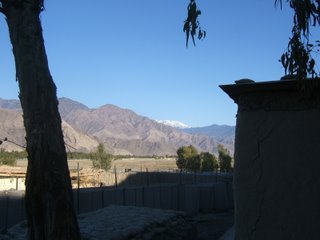
It's been a while since my last post but life here is busy and finding time to keep up with some things can be difficult. One of the first things you need to learn in this country is that the Afghans have their holidays and we don't have any. For me, Thanksgiving was no change from any of the stuff that I do on a regular basis. I left my forward "home" at Jalalabad that morning with the absolute knowledge that the 10th Mountain troops were going to have a great 4 hour meal with real turkey and all of the normal fixins'. Unfortunately, I had been tapped to escort one of our new Marine officers and some of his staff on a tour of our positions along both the Konar and Pech rivers. It was a two-day event and covered a lot of miles. We drove all morning and arrived at a site with a mess hall. A couple of the Marines in the group found some food and hooked us up with cold ham and macaroni and cheese, which was also cold. We left there after a short tour and a status update and headed for another Forward Operating Base (FOB) where we were scheduled to spend the night. We were hoping that the residents there were celebrating the holiday so we could have something like a turkey dinner. Once there we found out that their holiday meal had been served at lunchtime to allow their American Soldiers time to return to their remote locations before dark. Our dinner turned out to be chicken fajitas that were not bad, considering... The attached photo was taken the following morning at Camp Joyce. It shows the mountains along the Konar River just outside of Asadabad.
The next morning we ran further up along the border and visited another FOB that put us about 6 hours away from Jalalabad. We were running late and the Lieutenant Colonel I was with decided we should try and make it all the way back that night. We left at 3 PM and cut the 6 hour drive down to 3 hours and 5 minutes. For those of you that would love to ride in a HMMWV (military for Hummer) I defy you to find any fun in running the roads we were on for that length of time. Actually, our speed was low, usually around 30 MPH, but the roads are nothing more than wide, rutted trails. We made it back to the Jalalabad Airfield (our FOB) in time for dinner, a muscle relaxer and a bed.
The following day, as I was hobbling around our command post with the worst bachache I've had since I got here in June, everyone was telling me about the great meal that was served and the visit we had from LTG Eikenberry the Commanding General of Combined Forces Command, Afghanistan. I even got calls from other Soldiers bragging about the meals they had and all the stuff from home that accompanied it.
The only saving factor was that I got to see some of the troops that I had not seen in a few weeks and got to wish them a Happy Thanksgiving. No one was shooting at us on this trip so I had a lot to be thankful for. I'm also starting to get a bunch of stuff from supporters at home. Christmas trees and packages for the troops are rolling in on a daily basis. Our Afghan soldiers and their American counterparts are all looking forward to being back in the Kabul area soon. I will be trading in warm weather for the cold in the higher elevations but there will be a little less work and a trip home for two weeks after the first of the year so things are looking up.
